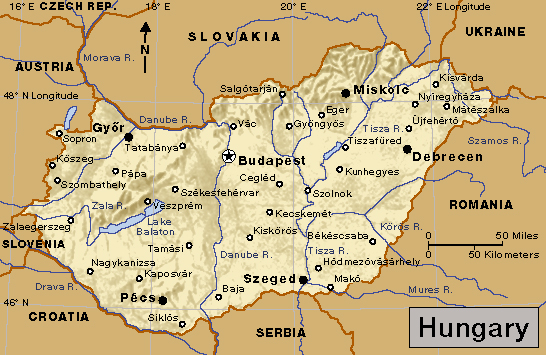Hungarian, the language of Hungary, is unlike most other languages of Europe. English, French, German, Italian, and Spanish, for example, all belong to the Indo-European language family. Hungarian, however, is a member of the Finno-Ugric group of languages, which is part of the Uralic language family. Hungarian is related to Estonian and Finnish.
An estimated 13 million people speak Hungarian, most of them in Hungary, where it is the official language. Ethnic Hungarians also make up substantial parts of the populations of such countries as Romania and Slovakia, where they tend to speak Hungarian among themselves. The Hungarian language, also known as Magyar, traces its roots back to the Magyar people, who originally lived between the Volga River and the Ural Mountains in what is now Russia. The Magyars started pushing west in the A.D. 500’s, and they eventually settled in the area that makes up modern Hungary. During the their westward migration, the Magyars came into contact with a number of other peoples whose languages influenced their own.

Through the years, Hungarian has adopted and adapted words from a number of other languages. Some scholars have suggested that the history of Hungary and the Magyars can be traced, in part, by the words it has borrowed from other languages. During the early migration of the Magyars to what is now Hungary, for example, they came into contact with groups of people who spoke Turkic and Iranian languages. Among the loan words from the Turkic languages are the words for apple (alma), wine (bor), and ankle (boka). Iranian borrowings include the words for bazaar or fair (vásár), cow (tehén), and milk (tej). The Hungarian words for cross (kërëszt) and cat (macska) were taken from the languages of neighboring Slavic peoples.

Stephen I, Hungary’s first king, ruled from about 1000 until 1038. As a result of Stephen’s rule, Hungary became closely identified with the culture and politics of western Europe. Stephen established the Roman Catholic Church as Hungary’s official religion. The language of the church was Latin, and numerous loan words from Latin made their way into the Hungarian language. Among them were the words for angel (angyal), ink (tinta), and school (iskola). The Hungarian language also uses the Roman (Latin) alphabet.
Over time, Hungarian picked up words from a number of other languages. From trading with Venice and other Italian cities from the 1200’s to the 1400’s, for example, Hungary borrowed and adapted many Italian words. For centuries, while Hungary was part of the Austrian Empire and the country of Austria-Hungary, many German words made their way into the Hungarian language.
Today, Hungarian continues to be a living, growing language. Among the relatively recent additions to the language, for example, are words related to technology, such as internet, cell phone (mobiltelefon), and computer (számítógép); terms from popular culture, such as superstar (szupersztár), action movie (akciófilm), and blockbuster (kasszasiker); and terms relating to medicine and the human body, such as medical genetics (orvosi genetika), gene therapy (génterápia), and arthroscopic surgery (artroszkópos sebészet).
By the way, in case you are wondering, the Hungarian word for Monday is hétfo.
Untitled Document
Can't view the linked articles? Subscribe to World Book Online

World Book Online delivers a progressive sequence of core databases supported by supplemental
tools, such as language translation, graphic organizers, and unique Webquests. Moving from
Early World of Learning to World Book Advanced, World Book Online aligns end-users with their
appropriate learning levels. Each stand-alone site provides additional features to support the
needs of users’ specific capabilities.
The World Book Difference
World Book combines cutting-edge technology with traditional editorial excellence to produce
authoritative, trustworthy, and unbiased content. The digital content is updated in real time and
carefully curated for each learning level. Accessible 24/7, the content is available on a variety of devices.
World Book Online combines 21st-century instructional techniques with timely information.
By breaking down complex topics and using easily understandable text, World Book Online helps to
build fluency and increase comprehension. Featuring single sign-on capability, these sites are paired
with highly visual content to engage even the most reluctant reader. Our collection of resources kindles
a lifelong learning experience for every user. This adherence to clarity, currency, and accuracy makes
World Book’s digital offerings an information hub for the classroom, library, and beyond.
Image 1: The Hungarian flag flies over millions of Hungarian speakers in Hungary. Credit: © Maximumvector/Shutterstock
Image 2: Hungary. Credit: WORLD BOOK map
Image 3: Hungarian belongs to the Uralic language family of far northern Europe and Asia. Credit: WORLD BOOK map